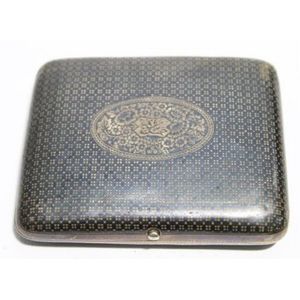1920s Hungarian Silver Cigarette Case with Monogram
A silver lady's cigarette case, circa 1920-30s, possibly Hungarian, with mark to hexagonal cartouche and other, engine turned to the top and with monogrammed cartouche, unadorned to the reverse; hallmarked to both the gilt washed lid and base. Total weight 64gr. Length 8 cm. Width 5.5 cm
You must be a subscriber, and be logged in to view price and dealer details.
Subscribe Now to view actual auction price for this item
When you subscribe, you have the option of setting the currency in which to display prices to $Au, $US, $NZ or Stg.
This item has been sold, and the description, image and price are for reference purposes only.
- Cartouche - An ornamental panel in the form of of a shield, oval or rectangular scroll with curling edges. It may be carved into the back of a chair or the top of a sideboard, or present on a piece of silver or jewellery, and contain the initials of the original owner, heraldic symbols, or some other inscription, such as the details of a presentation.
In ceramics the term defines the central area of a vase or similar with a decorative border in one of the shapes above, into which a decorative scene or figures have been painted. - Circa - A Latin term meaning 'about', often used in the antique trade to give an approximate date for the piece, usually considered to be five years on either side of the circa year. Thus, circa 1900 means the piece was made about 1900, probably between 1895 and 1905. The expression is sometimes abbreviated to c.1900.
- Engine Turned - Engine turning is a decorative technique used on metal surfaces to create intricate curving or geometric pattern. The process involves cutting a series of lines into the surface of the metal using a rose engine or decoration lathe which rotates the metal as it cuts, allowing the operator to create a repeating pattern that covers the entire surface. The resulting surface has a shimmering, reflective quality that is often described as "engine turned." Where an engine turned item has been enamelled, the term used to describe the decoration is usually guilloche.
Engine turning was originally developed to decorate metal objects such as firearms, scientific instruments, and other metal objects that required precise and elegant design.
This item has been included into following indexes:
Visually similar items

A silver niello cigarette case, 9 x 8 cm
Sold by
in
for
You can display prices in $Au, $US, $NZ or Stg.

George V sterling silver & gold powder compact Birmingham 1930s, date mark rubbed), maker W.H. Manton Ltd, machined decoration, with gold border. Weight 96 grams
Sold by
in
for
You can display prices in $Au, $US, $NZ or Stg.

935 sterling silver cigarette case
Sold by
in
for
You can display prices in $Au, $US, $NZ or Stg.

A wallet by Chanel, styled in black leather with embossed flower and 'CC' motif to one corner, 10.5 x 18.5 x 2 cm, boxed
Sold by
in
for
You can display prices in $Au, $US, $NZ or Stg.
